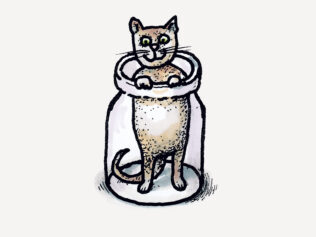
When there’s not much joy left at the end of one’s life, one might – in lieu of a last goodbye – treat their nearest and dearest to something so perverse that everyone would remember it for a long time.
The founder of the Getty Oil company, Jean Paul Getty, did all he could to ensure that his five wives, five sons and 14 grandchildren really hated him. His last wife, Louise “Teddy” Lynch, would never forgive the billionaire that when his son was dying of brain cancer, he never found the time to visit the boy. For four years, Getty bounced between the United Kingdom, Saudi Arabia and Kuwait, finalizing deals that soon made him the richest man in the world. Meanwhile, knowing that his son could not be saved, he asked his wife to keep expenses for his treatment to a minimum. “I don’t think doctors can do much for him now, except for a check-up, and that shouldn’t be more than $25,” he wrote to his wife. Later, he would call the hospital where Timothy Ware Getty was dying and argue with the administration about the cost of his treatment. When 12-year-old Timmy died in 1958, Teddy filed for divorce.
In this way, she joined the great many other relatives who hated Getty and waited for him to finally die and leave his fortune, estimated in the 1960s at around $2 billion.
Of course, Getty was well aware of this. In 1973, when the ‘Ndrangheta mafia abducted his 16-year-old grandson in Rome, he proved that he would not easily give up what he loved most to his heirs. Getty’s son and daughter-in-law begged Paul’s grandfather to lend them the ransom money – $17 million, an amount seemingly insignificant to the billionaire. He refused, and bargained with the kidnappers until they reduced the amount to $3 million. Then he gave his son the $2.2 million – the maximum amount that was tax deductible – and lent him the remaining $800,000 at 4% annual interest. Little details – such as the captors torturing his grandson and cutting off his ear – didn’t bother him too much. Even the Mafiosi, who eventually returned the boy alive, seemed to have been shocked at Getty’s callousness. Ridley Scott’s recent film, All the Money in the World, tells the story of the kidnapping.
Getty devoted the last years of his life to writing, rewriting and perfecting his last will. He changed it 21 times – disinheriting former wives and sons and grandchildren, or restoring their inheritance rights. Of course, he informed them about each change so that they would seek to get back into his good graces in order to protect their chances for inheritance.
However, they overlooked something that was to Getty far more important than his relatives. From 1954, at his residence on the Pacific shore near Los Angeles, the oil baron gradually expanded his art gallery. He collected both ancient Greek and Roman art alongside paintings of European old masters, creating one of the finest collections in the world. In 1974, he housed it in a new building, opening the J. Paul Getty Museum. When he finally died two years later and the will was opened, it turned out that the museum would receive a billion dollars, while the relatives would get the measly remainder. It seems that even in death, the billionaire had great fun manipulating his family, while simultaneously erecting a wonderful monument to himself.
Punishment from beyond the grave
Being accustomed to control and giving orders is put to a hard test when one’s children begin to form their own opinions. Queen Bona could not forgive her only son, Sigismund II Augustus, not only for his marriage to Barbara Radziwiłłówna, but also for many other displays of disobedience. And it hurt her the most when he completely removed her from power. The monarch did not intend to let this go unpunished and decided to return to the principality of Bari inherited from her father. Sigismund Augustus would have been overjoyed at her departure, but instead his mother schemed to take with her the entire fortune accumulated over the years. Queen Bona possessed enormous landed property within the Polish-Lithuanian Commonwealth, acquired while her husband Sigismund I the Old was still alive. And because she managed them so well, she acquired plenty of easily portable jewels and gold for her profits.
She informed her son that she was leaving in February 1556, just before setting off. She was going to warm Italy, supposedly just for treatment intended to rid her of rheumatic pains. Sigismund Augustus suspected a ruse, but was afraid that if he tried to stop his mother, she would poison him. Bona stripped the Warsaw castle of paintings, tapestries and tableware, loaded 24 wagons with valuables, and left.
For Sigismund Augustus, this was a painful blow. His overbearing mother removed a large part of the family fortune. What’s worse, this did not escape the attention of King Philip II of Spain. For the promise of the right to collect customs duties due to the Habsburgs in Italy, Bona agreed to lend him 430,000 ducats. One ducat contained about 3.5 grams of pure gold, so this amounted to one and a half tonnes of gold (today worth about £40 million).
Loaning Habsburg the money turned out to be a terrible idea. Gian Lorenzo Pappacoda, Bona’s courtier working for the Spanish ruler, bribed her doctor and cook, and ordered the poisoning of the queen. Next, he made sure that a notary was present to take down the will of the barely conscious, dying Bona. The principality of Bari and all of Bona’s riches were to go to Philip II. Unfortunately, Pappacoda did not foresee that one dose of poison would not be enough to kill the 63-year-old. Once Bona began to recover, she summoned a notary and prepared the will herself. In it, she forgave her son for disobeying her and generously bequeathed him both the principality and her enormous fortune. Still, the killers watched over her and a few days later the queen suddenly lost consciousness and passed away. Entangled in the plot, the notary managed to escape Bari before the Habsburg army entered. Although the assassins caught up with him, he managed to send Sigismund Augustus a letter informing him about the existence of two wills. This is how the epic that poisoned the later life of the Polish king began. The Habsburgs capturing his inheritance hurt Sigismund considerably more than the poisoning of his mother. However, as he was fighting a war for Livonia at the time, he could not afford to engage in an open conflict with a powerful enemy. Instead, he decided to send his emissaries to Naples. They founded a Polish diplomatic mission there and began suing the Habsburgs for the ‘Neapolitan sums’. Court proceedings dragged on for years, to meagre effect. In order to play down the scandal, Emperor Ferdinand I Habsburg convinced his relative Philip II to give the Polish ruler 10% of the value of the intercepted inheritance. This did not satisfy Sigismund Augustus. Until death, he fought for the remainder of his mother’s fortune, becoming increasingly frustrated with his powerlessness. In this way, Queen Bona’s intention to punish her son succeeded unexpectedly well after her death.
Fortunes of the elders
Georges Minois, the author of History of Old Age, claims that in Europe the aversion to old people grew every time that they had in their hands enough power and money to influence the life of the younger generation. This was the case in ancient Rome, and later again, in the late Middle Ages. Each time, curbing the freedom of the younger generation by the heads of families was the start of the conflict. Holding the full ownership of land and valuables, the bossy elders decided upon the future of their children. This concerned especially the choice of their spouse – after all, for both nobility and townspeople (and even peasants), marriage was an important transaction. Wanting to raise the prestige of the family, the head of the family would always look for his firstborn son to take a wife from a family of at least similar social status. They would not care so much about the younger sons, who would not inherit the majority of the estate. However, they would rather make them wait than risk a relationship with a partner who was not wealthy enough. The young did not have much to say during the negotiations – their marriage contracts were often drawn well before they reached puberty. They had to forget about the idea of romantic love under threat of disinheritance.
Hardly anyone managed to exercise the power of a patriarch as perfectly as Mayer Amschel Rothschild. He began to amass his fortune as the owner of a currency exchange office in the Jewish ghetto in Frankfurt am Main. He ended up as the official banker of the Principality of Hesse. Rothschild valued the bank he created above all else – he had no intention of letting his five sons and five daughters fritter away his life’s achievements. He provided an influential position for each of his male descendants. His eldest, Amschel, became a banker of the German Confederation; the younger Solomon held the office of the Habsburg treasurer at the court in Vienna. He sent his third son, Nathan, to London as the bank’s representative. The fourth, Jacob, gained the trust of the French Treasury Minister Nicolas Mollien, becoming his key advisor. Once he grew up, the last of the brothers, Carl, settled in Italy, becoming the banker of the local rulers and subsequent popes.
The ageing Rothschild, however, was losing sleep at the thought that his great financial empire would be divided. He made a will to prevent this. He wrote: “I will and ordain that my daughters and sons-in-law and their heirs have no share in the trading business existing under the firm of Mayer Amschel Rothschild and Sons […] and [that it] belong to my sons exclusively. None of my daughters, sons-in-law and their heirs is therefore entitled to demand sight of business transactions […] I would never be able to forgive any of my children if, contrary to these my paternal wishes, it should be allowed to happen that my sons were upset in the peaceful possession and prosecution of their business interests.” After disinheriting his daughters, he obliged his sons to maintain the unity of the international Rothschild Bank at all costs.
Following his death in 1812, the sons followed their father’s last will to a tee. The trouble was that they also had children. The two middle brothers came up with an idea of how to maintain the unity of the bank. The daughter of Salomon Rothschild married her uncle Jacob, thanks to which the property inherited by them stayed in the family. The other three brothers soon forced their children into similar relationships, and family fortune accumulated with each next generation. By the second half of the 19th century, no European financial institution could compete with the Rothschild’s bank.
Mayer Amschel’s last will, supplemented by an order to marry within the family, was obeyed for decades. Richard Conniff, the author of The Natural History of the Rich: A Field Guide cites geneticists who inform that at the end of the 20th century the ‘inbreeding coefficient’, a measure of just how closely the Rothchild family was related, was 0.064, “or 256 times greater than for a comparable family with normal outbreeding over five generations.” To put it simply: they were as closely related as if “they lived on an island cut off from the world inhabited by 38 people for five generations.”
Translated from the Polish by Joanna Figiel










